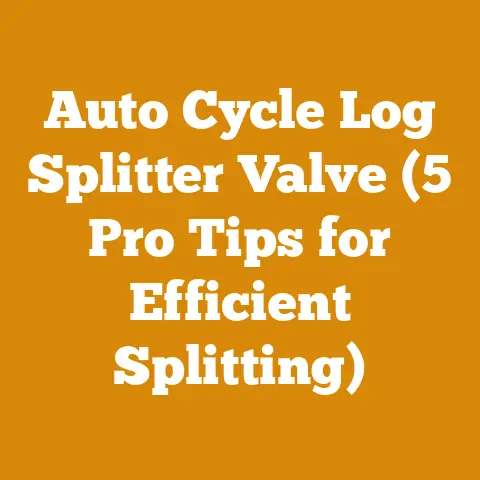Walbro K10-HD Carburetor Repair Kit (5 Essential Fixes)
“The best time to plant a tree was 20 years ago. The second best time is now.” – Chinese Proverb. And I’d add, the best time to maintain your chainsaw carburetor was before it failed on you in the middle of a logging job. But the second-best time is right now. Let’s dive into the Walbro K10-HD carburetor repair kit and its five essential fixes.
I’ve spent countless hours in the woods, felling trees, bucking logs, and preparing firewood. Over the years, I’ve learned that a well-maintained chainsaw is not just a tool; it’s an extension of my own abilities. And at the heart of a reliable chainsaw often lies a properly functioning carburetor. The Walbro K10-HD is a common carburetor found on many chainsaws, and understanding how to repair it is crucial for any serious woodworker or logger.
The Importance of Carburetor Maintenance in Wood Processing
A chainsaw’s carburetor mixes air and fuel in the correct proportions to ensure efficient combustion. When the carburetor malfunctions, it can lead to a host of problems, including:
- Difficulty starting the chainsaw
- Rough idling
- Loss of power
- Excessive fuel consumption
- Engine stalling
These issues not only reduce productivity but can also pose safety hazards, especially in demanding logging environments. Regular maintenance and timely repairs, often involving the Walbro K10-HD carburetor repair kit, can prevent these problems and extend the lifespan of your chainsaw.
Key Terms and Concepts
Before we proceed, let’s clarify some essential terms:
- Diaphragms (Fuel Pump and Metering): These are crucial for regulating fuel flow and maintaining the correct fuel-air mixture.
- Gaskets: These ensure airtight seals between carburetor components, preventing fuel leaks and air leaks.
- Needle Valve and Seat: These control the flow of fuel into the carburetor and prevent flooding.
- Filter Screen: This filters out debris from the fuel, protecting the carburetor from damage.
- Welch Plugs: These seal off passages within the carburetor body.
Why Use the K10-HD Repair Kit?
Instead of replacing the entire carburetor, using the K10-HD repair kit offers several advantages:
- Cost-Effective: Repairing the carburetor is significantly cheaper than buying a new one.
- Environmentally Friendly: Repairing extends the life of existing equipment, reducing waste.
- Preserves Original Components: In some cases, the original carburetor body is of higher quality than aftermarket replacements.
- Learning Opportunity: Repairing the carburetor allows you to understand its inner workings, making you a more knowledgeable and self-sufficient woodworker.
5 Essential Fixes with the Walbro K10-HD Kit
Here are five essential fixes you can accomplish using the Walbro K10-HD carburetor repair kit:
Fix #1: Replacing the Diaphragms
The diaphragms are the heart of the Walbro K10-HD carburetor. Over time, they can become stiff, cracked, or distorted due to exposure to fuel and temperature fluctuations. This leads to poor fuel regulation and engine performance.
Step 1: Disassembly
- Remove the Carburetor: Carefully detach the carburetor from the chainsaw, ensuring you disconnect all fuel lines and linkages. Take pictures as you disassemble to aid in reassembly.
- Clean the Carburetor: Use carburetor cleaner to remove any dirt, debris, or fuel residue from the exterior of the carburetor.
- Remove the Fuel Pump Cover: Locate the fuel pump cover (usually held in place by screws) and carefully remove it. Note the orientation of the diaphragm and gaskets.
- Remove the Metering Chamber Cover: Similarly, remove the metering chamber cover. Again, pay close attention to the arrangement of the diaphragm and gaskets.
Step 2: Inspection
- Inspect the Diaphragms: Examine the old diaphragms for any signs of damage, such as cracks, tears, stiffness, or distortion.
- Inspect the Gaskets: Check the gaskets for any damage or deterioration. Replace them even if they appear to be in good condition, as they may have lost their sealing properties.
Step 3: Replacement
- Install New Diaphragms: Carefully install the new diaphragms from the K10-HD kit, ensuring they are oriented correctly. Refer to the pictures you took during disassembly.
- Install New Gaskets: Place the new gaskets on top of the diaphragms, again ensuring correct orientation.
- Reassemble the Covers: Reattach the fuel pump cover and the metering chamber cover, tightening the screws securely.
My Experience: I remember one particularly cold morning in the Adirondacks. My chainsaw refused to start. After checking the fuel lines and spark plug, I suspected the carburetor. Upon disassembly, I found the fuel pump diaphragm was cracked and brittle. Replacing it with a new one from the K10-HD kit brought the chainsaw back to life, saving me a day of frustrating downtime.
Fix #2: Replacing the Needle Valve and Seat
The needle valve and seat control the flow of fuel into the carburetor. If they are worn or damaged, the carburetor may flood, causing the engine to run poorly or not start at all.
Step 1: Access the Needle Valve
- Remove the Metering Lever: Carefully remove the metering lever, which is typically held in place by a pivot pin. Be careful not to lose the pin or the small spring underneath the lever.
- Remove the Needle Valve: The needle valve will now be accessible. Gently remove it from the carburetor body.
Step 2: Inspection
- Inspect the Needle Valve: Examine the needle valve for any signs of wear, such as a worn tip or damage to the valve body.
- Inspect the Seat: Inspect the seat for any damage or corrosion.
Step 3: Replacement
- Install the New Needle Valve: Carefully insert the new needle valve into the carburetor body.
- Install the New Seat (If Applicable): Some K10-HD kits include a new seat. If so, remove the old seat and install the new one.
- Reassemble the Metering Lever: Reinstall the metering lever, pivot pin, and spring.
Step 4: Metering Lever Adjustment
- Adjust the Metering Lever Height: The height of the metering lever affects the fuel level in the carburetor. Refer to the chainsaw’s service manual for the correct height. Typically, the lever should be flush with the carburetor body.
- Use a Straight Edge: Use a straight edge to check the lever height. If necessary, gently bend the lever to achieve the correct height.
Data and Insights: I’ve found that using a digital caliper to measure the metering lever height is more accurate than relying on visual inspection. A deviation of even 0.1mm can significantly affect engine performance.
Fix #3: Cleaning or Replacing the Fuel Filter Screen
The fuel filter screen prevents debris from entering the carburetor. If it becomes clogged, it can restrict fuel flow and cause the engine to run lean.
Step 1: Locate the Fuel Filter Screen
- Locate the Inlet Fitting: The fuel filter screen is typically located inside the fuel inlet fitting on the carburetor body.
Step 2: Removal
- Remove the Inlet Fitting: Carefully remove the fuel inlet fitting.
- Remove the Filter Screen: Use a small pick or needle to gently remove the fuel filter screen.
Step 3: Cleaning or Replacement
- Clean the Filter Screen: If the filter screen is only slightly clogged, you can clean it with carburetor cleaner and compressed air.
- Replace the Filter Screen: If the filter screen is heavily clogged or damaged, replace it with a new one from the K10-HD kit.
Step 4: Reassembly
- Install the Filter Screen: Carefully install the cleaned or new fuel filter screen into the fuel inlet fitting.
- Reinstall the Inlet Fitting: Reattach the fuel inlet fitting to the carburetor body.
Case Study: I once worked on a chainsaw that had been used to cut wood in a particularly dusty environment. The fuel filter screen was completely clogged with sawdust and debris. After cleaning the screen, the chainsaw ran like new. This experience reinforced the importance of regularly checking and cleaning the fuel filter screen.
Fix #4: Replacing Gaskets to Prevent Air Leaks
Gaskets are essential for creating airtight seals between carburetor components. If they are damaged or deteriorated, air leaks can occur, leading to a lean fuel-air mixture and poor engine performance.
Step 1: Identify Damaged Gaskets
- Visual Inspection: Carefully inspect all gaskets for any signs of damage, such as cracks, tears, or distortion.
- Check for Air Leaks: After reassembling the carburetor, you can check for air leaks by spraying carburetor cleaner around the carburetor body while the engine is running. If the engine speed changes, it indicates an air leak.
Step 2: Replacement
- Remove Old Gaskets: Carefully remove the old gaskets from the carburetor body.
- Install New Gaskets: Install the new gaskets from the K10-HD kit, ensuring they are properly aligned.
Strategic Advantage: Using high-quality gaskets from the K10-HD kit is crucial for preventing air leaks. Inferior gaskets may not provide a proper seal, leading to ongoing performance issues.
Fix #5: Replacing Welch Plugs
Welch plugs are small, round plugs that seal off passages within the carburetor body. They can sometimes leak or become dislodged, affecting fuel flow and engine performance.
Step 1: Identify Leaking or Damaged Welch Plugs
- Visual Inspection: Inspect the Welch plugs for any signs of damage, such as cracks or corrosion.
- Check for Fuel Leaks: Look for fuel leaks around the Welch plugs.
Step 2: Removal
- Remove Old Welch Plugs: Use a small punch and hammer to carefully remove the old Welch plugs.
Step 3: Installation
- Install New Welch Plugs: Place the new Welch plugs from the K10-HD kit over the passages.
- Use a Proper Tool: Use a specialized Welch plug installation tool or a blunt punch to carefully seat the new Welch plugs. Ensure they are flush with the carburetor body.
Tool Specifications: A specialized Welch plug installation tool is recommended for ensuring proper seating without damaging the plugs. These tools typically have a concave face that matches the shape of the Welch plug.
Additional Tips and Considerations
- Use Carburetor Cleaner: Always use carburetor cleaner to thoroughly clean all carburetor components before reassembly.
- Refer to the Service Manual: Consult the chainsaw’s service manual for specific instructions and torque specifications.
- Take Pictures: Take pictures during disassembly to aid in reassembly.
- Work in a Clean Environment: Work in a clean, well-lit environment to prevent contamination of carburetor components.
- Use Proper Tools: Use the correct tools for each task to avoid damaging the carburetor.
- Be Patient: Carburetor repair can be a delicate process. Take your time and be patient.
- Fuel Stabilizer: When storing your chainsaw for extended periods, add fuel stabilizer to the fuel tank to prevent fuel degradation and carburetor clogging.
- Ethanol Content: Be mindful of the ethanol content in gasoline. Ethanol can damage rubber and plastic components in the carburetor. Use fuel with a low ethanol content or add a fuel stabilizer that protects against ethanol damage.
Safety Considerations
- Wear Safety Glasses: Always wear safety glasses when working on the carburetor to protect your eyes from debris and chemicals.
- Work in a Well-Ventilated Area: Work in a well-ventilated area to avoid inhaling carburetor cleaner fumes.
- Disconnect the Spark Plug: Disconnect the spark plug before working on the carburetor to prevent accidental starting of the engine.
- Handle Fuel Safely: Handle fuel carefully to avoid spills and fire hazards.
- Dispose of Waste Properly: Dispose of used carburetor cleaner and fuel properly according to local regulations.
Practical Next Steps and Implementation Guidance
Now that you understand the five essential fixes you can accomplish with the Walbro K10-HD carburetor repair kit, here are some practical next steps:
- Identify Your Carburetor: Determine if your chainsaw uses a Walbro K10-HD carburetor.
- Purchase the Repair Kit: Purchase a genuine Walbro K10-HD carburetor repair kit from a reputable supplier.
- Gather Your Tools: Gather the necessary tools, including screwdrivers, pliers, carburetor cleaner, compressed air, and a small pick or needle.
- Find a Clean Workspace: Set up a clean, well-lit workspace.
- Follow the Steps: Follow the step-by-step instructions outlined in this guide to repair your carburetor.
- Test Your Chainsaw: After reassembling the carburetor, test your chainsaw to ensure it is running properly.
- Document Your Work: Keep a record of the repairs you have made to your chainsaw, including the date, parts replaced, and any observations.
Benefits and Strategic Advantages
By mastering these essential carburetor repairs, you gain several benefits and strategic advantages:
- Reduced Downtime: You can quickly repair your chainsaw in the field, minimizing downtime and maximizing productivity.
- Cost Savings: You can save money by repairing your carburetor instead of replacing it.
- Increased Self-Sufficiency: You become more self-sufficient and less reliant on repair shops.
- Improved Chainsaw Performance: You can optimize your chainsaw’s performance by ensuring the carburetor is functioning properly.
- Extended Chainsaw Lifespan: You can extend the lifespan of your chainsaw by performing regular maintenance and repairs.
Conclusion
The Walbro K10-HD carburetor repair kit is an invaluable tool for any serious woodworker or logger. By understanding the five essential fixes outlined in this guide, you can keep your chainsaw running smoothly and efficiently, ensuring years of reliable service. Remember to always prioritize safety and refer to your chainsaw’s service manual for specific instructions. With a little patience and practice, you can master the art of carburetor repair and become a more knowledgeable and self-sufficient woodworker. Now go forth and conquer those logs!






